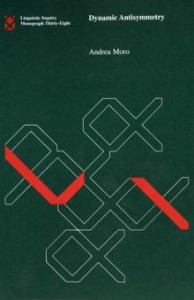Dynamic antisymmetry
 The central idea of Dynamic Antisymmetry is that movement and phrase structure are not independent properties of grammar; more specifically, that movement is triggered by the geometry of phrase structure. Assuming a minimalist framework, movement is traced back to the necessity for natural language to organize words in linear order at the interface with the perceptual-articulatory module. Andrea Moro uses this innovative perspective to analyze several empirical domains, focusing on small clauses, split wh-movement, and clitic constructions. In a final speculative chapter, he examines the general consequences for the design of grammar implied by Dynamic Antisymmetry. The book is self-contained, with a synopsis of current theories of movement and a synthetic presentation of the theory of antisymmetry. An appendix presents the essentials of a unified theory of copular sentences, which plays a central role in the argument and has several important consequences for syntax, for example, for expletives and locality.
The central idea of Dynamic Antisymmetry is that movement and phrase structure are not independent properties of grammar; more specifically, that movement is triggered by the geometry of phrase structure. Assuming a minimalist framework, movement is traced back to the necessity for natural language to organize words in linear order at the interface with the perceptual-articulatory module. Andrea Moro uses this innovative perspective to analyze several empirical domains, focusing on small clauses, split wh-movement, and clitic constructions. In a final speculative chapter, he examines the general consequences for the design of grammar implied by Dynamic Antisymmetry. The book is self-contained, with a synopsis of current theories of movement and a synthetic presentation of the theory of antisymmetry. An appendix presents the essentials of a unified theory of copular sentences, which plays a central role in the argument and has several important consequences for syntax, for example, for expletives and locality.


